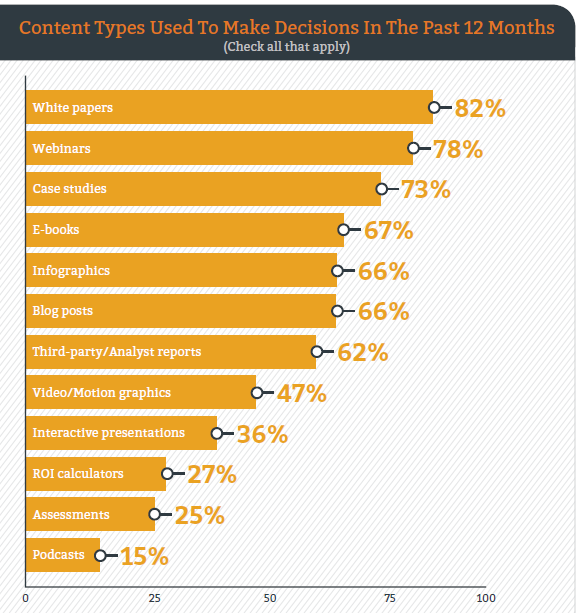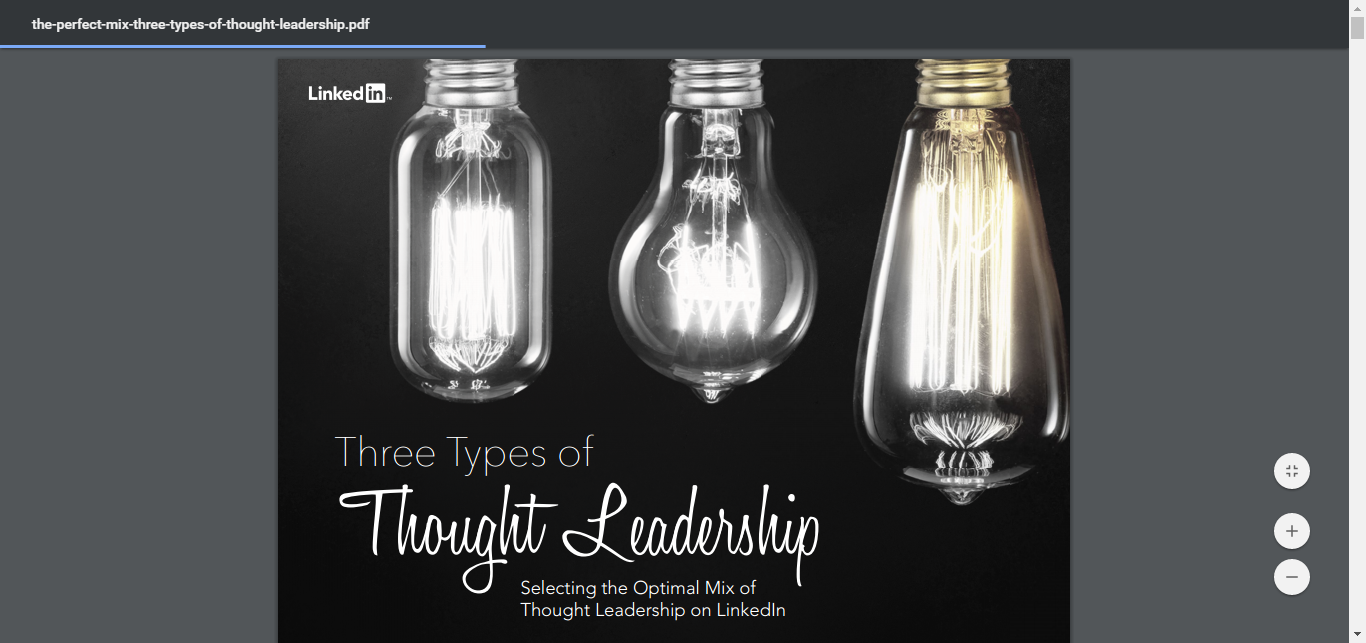
Let’s get a few things straight: White papers aren’t documents full of text rambling on aimlessly. Rather, they’re akin to detailed reports on specific topics to be published for specific online readership. White papers are longer than blog posts; they can be up to ten pages long. They’re not meant for casual reading. They’re typically written by experts and are supported by intensively researched data, statistics, illustrations, charts, and references. Writing a good white paper is no walk in the park and can take several months to shape up properly.
Did you know that white papers were the most preferred content type used to make buying decisions in the last 12 months? Further, white papers, ebooks and webinars were the top three in 2015 when it came to most valued content types. Buyers are most likely to share white paper content with their colleagues.

Why Write White Papers?
When you write white papers, you can look forward to the following benefits:
- It helps the business generate higher sales and earn more credibility and trust, as its main purpose is to provide solutions to readers’ problems. Readers tend to respond better to genuinely helpful information rather than to advertisements.
- It inspires curiosity about your offerings among customers without having to make direct mentions of your products and services.
- If your white paper goes viral, it will be read by executives at large corporations, who may go on to vouch for you. This brings your business more credibility.
- People are always in search of quality content on the web. If your content is, indeed, professional in quality, it will help you engage your readers without overwhelming them. If they remain focused, your business can get the most out of it.
- White papers engage readers by addressing customers’ problems first and then providing them with solutions. By offering solutions right at the beginning, your readers will lose interest. It is, therefore, important to prioritize readers’ interest over your own. By doing so, your paper will motivate them to take action and buy your problem-solving product.
If you’re wondering how you can create an outstanding white paper, you’ve come to the right place. Here are a few steps to help you with it.
1. Consider Your Overall Content Marketing Strategy
When creating a white paper, make sure that the final result fits in with your content marketing strategy. White papers are written with certain objectives in mind and are meant to help you build thought leadership in your field. At the same time, they should also provide resolutions to the pain points of your target audience.
It will be easier to convert prospects through a white paper if the content addresses readers’ needs at a particular point in the buying cycle. Further, regularly publishing white papers that focus on a particular area can help you achieve ownership of related search terms on search engines.
2. Do Not Compromise on Its Promotion
Creating white papers can take a while, which is why many businesses may be tempted to push them out as soon as they are ready without promoting it adequately. This can be a huge mistake. It is important to put in equal (if not more) time and effort in promoting it as well.
When promoting your white paper, you can break up the content into small, digestible pieces so that your readers find it easy to read. This will attract more traffic. Put into action your in-house digital marketing team, or collaborate with external agencies to use available promotional platforms like social media, email, newsletters, search engine marketing, and so on to get people talking about your paper.
3. Maintain Quality and Professionalism
A white paper is supposed to be written by experts, so framing one with a casual tone is a strict no-no if you want to make it influential. It is better to stick to professional writing practices and be descriptive about the topic you’re addressing. The fact that a white paper is descriptive in nature is what makes it a long document. Use this opportunity to make your point.
Adobe came out with a 15-page whitepaper for business professionals looking for expert and detailed information on document security. Their white paper named “Global Insights on Document Security” is all about everything an IT professional will need to know about when deciding on their business’s document and file security practices.
4. Choose an Interesting Topic and Title
One of the biggest factors that will attract (or repel) your readers towards your white paper is the topic or the title.
White papers by Pardot are exemplary in this matter. Their topics and titles are concise yet self-explanatory enough to tell readers what they can expect from the read. For example, their title “The Marketing Automation Success Kit” conveys clearly that the white paper contains everything they need to know about marketing automation, and they need not refer any other resource.
Further, think about what people want to read rather than what you want them to read. Finding a topic that resonates with the majority of readers can be a challenge. It is crucial that you figure out who your target audience is and then choose an issue that may be of interest to them. This could be anything from a common problem they may be facing to a detailed analysis of successful businesses in your industry.
5. Offer Value
A good white paper is more about using a collection of facts to provide solutions to audiences’ problems than an advertising platform. You can use a white paper to position yourself as an industry expert with insights to help your readers. It is, therefore, important that your paper offers great value. You can do this by inundating it with useful information and tips. Call attention to the value that you’ve created, and the readers may actually buy from you in the future.
Hootsuite does a great job of providing valuable solutions to entrepreneurs struggling with running a social business through its whitepaper titled “8 Tips for Social Businesses.” Their white paper is seven pages long and also includes a concluding page that describes the company and talks about some of their best clients.
6. Organize Well
Because a white paper can be up to ten pages long, it is easy to lose your train of thought in the midst of writing it. This is why organizing your draft is critical. It is better to have a clear outline in place from the outset so that it becomes easy to write the paper thereafter. Consistency matters, and it will also help you maintain the flow. The idea is to get readers’ attention, deliver value in line with your goals, and push them to act.
“Three Types of Thought Leadership” by LinkedIn is a great example of a white paper that shows its efficacy by paying attention to consistency in its art theme. The cover pages have light bulbs on them, a theme that is extrapolated to the entire document (light bulbs in the background on almost every page). This exhibits the value LinkedIn places on consistency and their emphasis on presenting their material in a well-organized manner.

Another of the best ways to get readers’ attention from the very beginning is by framing a great introduction. Tell them what they can expect to accomplish by reading your white paper with the help of a summary and the list of topics it covers.
7. Write, Edit, Proofread
Simply having an outline in place doesn’t guarantee that you will eventually have a great white paper. You need to put your thoughts in black and white while they’re still fresh in your mind. Focus on finishing the writing first and editing later.
You’ll also need to proofread the draft until it’s perfect. During this process, ask other people to go through it, give you feedback, and catch the errors you may have overlooked. If possible, read it aloud to yourself to ensure that there is no redundancy, repetition, or awkward sentences and phrases.
[contextly_auto_sidebar]
8. Tell Them How It Can Help, Again
Of course, it is important to mention to your readers as to how your white paper will help them in the beginning of the paper. However, it will help if you reiterate this at the end as well. This does not mean that you try to sell you product or services in the body of the content. Just ensure that you include a catch as naturally as possible into the paper when you conclude it.
9. Keep Measuring Results
Is your white paper bringing in the desired results? Is it getting enough shares on the desired platforms? How will you know what your ROI is until you actually measure it?
The good news is that several content marketing platforms such as ClearVoice, Content Launch, Contently, CrowdSource, and so on that allow you to measure factors such as social shares, leads generated and touched, pipeline generated and touched, and revenue created.
Use them to your advantage. Find out what is lacking where, and make the necessary tweaks to increase the reach of your white paper to the maximum extent.
If you’re a business that’s looking to generate credibility and establish its authority in the market as an expert, then writing a great fact-based white paper may be the way to go. Customers are always on the lookout for information that adds value to their life, and a well-written white paper can do exactly that. All you need to ensure is that it’s well-planned and the flow is systematic so that it piques readers’ interest and, hopefully, turns them into loyal customers. The above tips can go a long way in helping you create white papers that bring you credibility and clout.
Get more content like this, plus the very BEST marketing education, totally free. Get our Definitive email newsletter.

